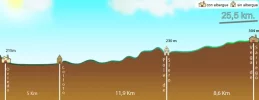Thornily, I have talked with several who have done the way from Mont St Michel who thought that it was quite easy, so again, it depends on a lot of factors. For me, one day that stands out that I would have classified as really "difficult " was the first day on the "Alpinist" route of the del Norte. After several kilometers, I decided to take an alternative route, which was not bad for much of the route, however, I got lost 3 times, finding the way marking lacking, never passed through a town or found a place for water, which was probably due to my lack of research, so I found myself having no food for the 11 hour trek and ran out of water with four hours to go and became on the verge of dehydration. The last 2 1/2 hours were the toughest as the trail was very narrow on the crest of the mountain and if you were not alert, there were steep drop offs to the valley on the left and to the sea on the right. This did not bode well for someone who is someone afraid of heights. Realizing the difficulty in several places a cable was tacked to rocks to hold on to help with anyone having difficulty. Unfortunately, I only came across a few pilgrims and mostly day packers with tiny packs or no packs at all. That also created some anxiety. Upon arriving at my destination, I collapsed, almost ready to give up on my camino after the first day. To me that was a difficult day and route. I talked with several others who had taken different routes, passed through towns, found water and had no problems. I have walked several caminos in France, Spain and Portugal and have never before had quite that experience. I might mention that I was not in as good a shape as I have been on previous caminos, so that was probably at least a small factor. Sorry for the rambling, but the point that I am trying to make is that there are many factors that go into how difficult or easy a given "route" might be. What's difficult for one may be very easy for someone else for any number of different reasons as is the case with the way out of Mont St Michel.
Hi rickster,
Keep rambling as its enlightening and will bring back memories to a few.
There are 2 ways from Mont St Michel,
1/To Rennes and the coast
2/To St James , Vitre etc inland.
We chose inland and thats where the problem started.
The coastal path was beside the causeway , lovely gravel path , 4 metres wide and signs on lamp posts.
The inland way was amongst a construction site , the path was moved and the grass was a metre high , no hope of seeing the way.
For the first 300km [ **thats Burgos on the Frances] we met ***6 pilgrims*** , all heading to Mont St Michel ***none going our way and in late april early may you must remember we were in Brittany and that means H2O , often and heavy.
The signs were hard to find and there was no relevant GR to assist.
I concur about the first days of the Norte .
To overcome that section we walked from Biarritz and took 2 days before the normal start.
We stopped at Hondarribia and then again at Pasajas San Juan before San Sebastian.
These were short days because of the terrain you mentioned and we believe in always commencing with short days as damage is always done at the start.
**I have a big desire to walk the Frances only using the touristo information and taking 40-45 days.
But Her Majesty just shakes her head.
The only time i was worried about heights and terrain came on the Le Puy way.
Just out of Monistrol -D'Allier [ 2nd day] there is a climb of 400m [ 600m to 1000m ] in 3km. You are beside the cliff overlooking the river before you reach the Chapelle of Madeleine , path is half a metre wide and its dangerous , especially if wet.
You would be mad to attempt late in the day or in heavy rain.
On reaching the Chapelle you are given access to a rope hand rail and rough ad hoc concrete steps , as the path is now a water way to the river from the mountain top.



















